Popular categories
Looking for a yarn?
Order DROPS Kid-Silk from Trgovinca iNCA

|
DROPS Kid-Silk uni colour 75% Mohair, 25% Silk |
5.05 € /25g |
Order |
Clicking the ORDER button will redirect you to Trgovinca iNCA website
The yarn cost is calculated from the pattern’s smallest size and the yarn’s cheapest product type. Looking for an even better price? You might find it on the DROPS Deals!
North Woods Sweater
Knitted jumper with raglan in DROPS Sky and DROPS Kid-Silk. Piece is knitted with vents in the sides. Size: S - XXXL
DROPS design: Pattern sk-112
Yarn group B and A
-------------------------------------------------------
SIZE:
S - M - L - XL - XXL - XXXL
MATERIALS:
DROPS SKY from Garnstudio (belongs to yarn group B)
250-250-300-300-350-400 g colour 07, light sea green
And use:
DROPS KID-SILK from Garnstudio (belongs to yarn group A)
100-125-125-150-150-175 g colour 35, chocolate
KNITTING TENSION:
16 stitches in width and 20 rows vertically in stocking stitch and 1 strand of each quality = 10 x 10 cm.
NEEDLES:
DROPS DOUBLE POINTED NEEDLES SIZE 5.5 mm
DROPS CIRCULAR NEEDLE SIZE 5.5 mm : Length 40 and 80 cm for stocking stitch.
DROPS DOUBLE POINTED NEEDLES SIZE 4 mm
DROPS CIRCULAR NEEDLE SIZE 4 mm : Length 40 and 60 or 80 cm for rib.
Needle size is only a suggestion! If you have too many stitches on 10 cm switch to a larger needle size. If you have too few stitches on 10 cm switch to a smaller needle size.
-------------------------------------------------------
Alternative Yarn – See how to change yarns here
Yarn Groups A to F – Use the same pattern and change the yarn here
Yarn usage using an alternative yarn – Use our yarn converter here
-------------------------------------------------------
Women Jumpers Basic Jumpersbottom up double neck high neck raglan round neck stocking stitch
Order DROPS Sky from Trgovinca iNCA

|
DROPS Kid-Silk uni colour 75% Mohair, 25% Silk 5.05 € /25g Order |
Clicking the ORDER button will redirect you to Trgovinca iNCA website
The yarn cost is calculated from the pattern’s smallest size and the yarn’s cheapest product type. Looking for an even better price? You might find it on the DROPS Deals!
- English (UK/cm), Slovenia
- Česky - not translated
- Dansk
- Deutsch
- Eesti keel - not translated
- English (UK/cm)
- English (US/in)
- Español
- Français
- Íslenska
- Italiano
- Magyar
- Nederlands
- Norsk
- Polski
- Português
- Suomi
- Svenska
- English (UK/cm), Bulgaria
- English (UK/cm), Croatia
- English (UK/cm), Greece
- English (UK/cm), Latvia
- English (UK/cm), Lithuania
- English (UK/cm), Romania
- Česky, Slovakia - not translated
Pattern instructions
EXPLANATION FOR THE PATTERN:
-------------------------------------------------------
GARTER STITCH (back and forth):
Knit all rows.
1 ridge vertically = knit 2 rows.
DECREASE TIP (evenly):
To calculate how to decrease evenly, use the number of stitches decreases are done over (e.g. 89 stitches) , and divide stitches by number of decreases to be done (e.g. 16) = 5.6. In this example decrease by knitting alternately approx. every 4th and 5th stitch and every 5th and 6th stitch together.
INCREASE TIP (applies to sleeves):
Work until 2 stitches remain before marker thread, 1 yarn over, knit 4 (marker thread is in the middle of these stitches), 1 yarn over. On next round knit yarn overs twisted to avoid holes. Then work the new stitches in stocking stitch.
RAGLAN:
Decrease like this in every transition between body and sleeves: Work until 1 stitch remains before stitch with marker, slip 2 stitches as if knitted together, knit 1, pass the 2 slipped stitches over stitch worked. Repeat at every marker (= 8 stitches decreased on round).
CAST-OFF TIP:
To avoid a tight cast-off edge you may use a larger needle size. If this also is too tight, work a 1 yarn over after approx. every 4th stitch while casting off (cast off yarn overs as regular stitches).
-------------------------------------------------------
START THE PIECE HERE:
-------------------------------------------------------
JUMPER - SHORT OVERVIEW OF THE PIECE:
Work front and back piece back and forth separately until rib and vent in each side are done. Then slip parts on to same circular needle and work in the round up to armholes. Sleeves are worked in the round on double pointed needles/a short circular needle up to armhole. Then slip sleeves on to same circular needle as body and work yoke in the round. Work neck edge in the round on a short circular needle at the end.
BACK PIECE:
Cast on 91-101-109-117-129-141 stitches (including 1 edge stitch in garter stitch in each side) on circular needle size 4 mm with 1 strand Sky and 1 strand Kid-Silk (= 2 strands). Purl 1 row from wrong side. Then work rib as follows:
ROW 1 (= right side): 1 edge stitch in GARTER STITCH - read explanation above, * knit 1 twisted, purl 1 *, work from *-* until 2 stitches remain on needle, knit 1 twisted and finish with 1 edge stitch in garter stitch.
ROW 2 (= wrong side): 1 edge stitch in garter stitch, * purl 1 twisted, knit 1 *, work
from *-* until 2 stitches remain on row, purl 1 twisted and finish with 1 edge stitch in garter stitch.
Repeat 1st and 2nd row until rib measures 15 cm. Put piece aside and work the front piece.
FRONT PIECE:
Cast on and work the same way as back piece until rib measures 15 cm - adjust so that next row is worked from right side.
BODY:
Knit 1, knit the next 89-99-107-115-127-139 stitches and decrease at the same time 16-20-22-22-24-26 stitches evenly – read DECREASE TIP, knit last stitch on front piece together with first stitch on back piece (= 1 stitch decreased), insert a marker thread here (= in the side), knit the next 89-99-107-115-127-139 stitches on back piece and decrease at the same time 16-20-22-22-24-26 stitches evenly, knit last stitch on back piece together with first stitch on front piece, insert a marker thread here (= in the side and this is beginning of round). There are now 148-160-172-188-208-228 stitches on round.
Switch to circular needle size 5.5 mm. Work in stocking stitch in the round. REMEMBER THE KNITTING TENSION!
When piece measures 33-33-34-34-34-34 cm, cast off 8-8-10-10-12-12 stitches for armholes in each side (i.e. 4-4-5-5-6-6 stitches on each side of marker thread in each side) = 66-72-76-84-92-102 stitches for front and back piece. Put piece aside and work the sleeves.
SLEEVES:
Cast on 46-48-50-52-52-56 stitches on double pointed needles size 4 mm with 1 strand Sky and 1 strand Kid-Silk (= 2 strands). Now work in the round as follows: Knit 1 round. Then work rib (= knit 1 twisted/purl 1) in the round for 5 cm.
Knit 1 round while decreasing 8-8-8-8-8-10 stitches evenly – remember DECREASE TIP = 38-40-42-44-44-46 stitches. Switch to double pointed needles size 5.5 mm. Insert a marker thread at beginning of round (= mid under sleeve). Move the marker thread when working; it is used for increase under sleeve later. Work in stocking stitch in the round. When piece measures 8-8-7-8-8-8 cm from cast-on edge, increase 1 stitch on each side of marker thread - read INCREASE TIP. Increase like this approx. every 3-3-2½-2-1½-1½ cm 10-10-12-13-15-15 times in total = 58-60-66-70-74-76 stitches. When sleeve measures 39-38-37-35-34-32 cm, cast off the middle 8-8-10-10-12-12 stitches under sleeve (i.e. 4-4-5-5-6-6 stitches on each side of marker thread) = 50-52-56-60-62-64 stitches. Put piece aside and knit another sleeve the same way.
YOKE:
Slip sleeves on to same circular needle as body where armholes were cast off = 232-248-264-288-308-332 stitches. Insert a marker thread mid back on back piece (= 33-36-38-42-46-51 stitches on each side of marker thread on back piece). This is now the beginning of round. Insert a marker in the outermost stitch in each side of back piece and front piece (= 64-70-74-82-90-100 stitches between stitches with marker on front piece and back piece and 50-52-56-60-62-64 stitches on sleeves). Use markers later when decreasing for raglan.
Work in stocking stitch in the round. When yoke measures 3-4-3-3-3-4 cm, begin decrease for RAGLAN – read explanation above. Decrease like this every other round 18-19-21-23-25-26 times in total = 88-96-96-104-108-124 stitches. When all decreases are done, the piece should measure 21-23-24-26-28-30 cm if the knitting tension is maintained vertically. Knit 1 round while decreasing 14-20-16-20-20-32 stitches evenly = 74-76-80-84-88-92 stitches.
NECK EDGE:
Switch to a short circular needle size 4 mm. Work rib (knit 1 twisted/purl 1) in the round for 10 cm. Cast off with knit over knit and purl over purl - read CAST-OFF TIP. The neck edge can be folded outwards, or it can be folded inwards and fasten to form a double neck edge as follows:
Fold rib at the top of neck down on the inside of garment. Fasten rib to form a folding edge. To avoid a tight neck edge and avoiding the edge to tip outwards, it is important to make the seam elastic.
ASSEMBLY:
Sew the openings under the sleeves together.
Diagram
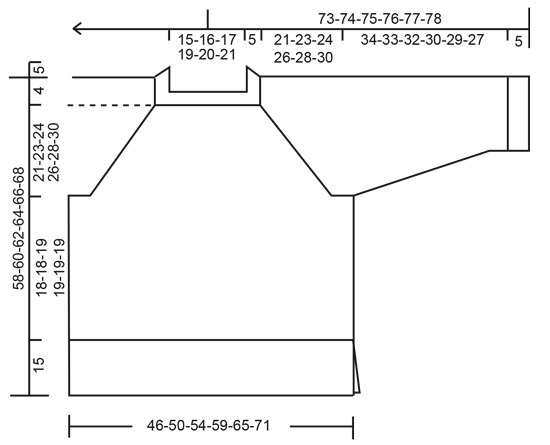
What can you do with our patterns? You can share DROPS patterns online, using the pattern original picture, materials, name and number. But you are NOT ALLOWED to reproduce the complete pattern digitally in any way. Yarn stores are welcome to use the DROPS pattern database to promote the sale of our assortment. You can print out our patterns, make as many copies as you’d like. The only thing we ask is that you don't make any changes / additions to the original printed document. And that the patterns according to the DROPS philosophy are given out to the consumers for free. Editorials that wish to publish our patterns in printed books or magazines can contact us for more information. The sale of garments based on DROPS patterns is permitted as long as they are sold as single items or per order. Further commercial use of the patterns is not permitted. It has to be clearly stated that the garment is made based on a design from DROPS DESIGN. The use of clothing labels of which DROPS DESIGN forms part is conditioned by the inclusion of the following text: “A DROPS DESIGN made by …..”. The use of DROPS photos for marketing purposes/sales is only permitted in connection with the use/sale of DROPS products. The photos may not be cut or edited and the logo should be clearly visible.
We reserve the right to withdraw the permission for use of our patterns at any time, notwithstanding the reason.
Each of our patterns has specific tutorial videos to help you.
These step-by-step tutorials might also help you:
Why is the knitting/crochet tension so important?
Knitting tension is what determines the final measurements of your work, and is usually measured per 10 x 10 cm. It is provided like so: number of stitches in width x number of rows in height - eg: 19 stitches x 26 rows = 10 x 10 cm.
The knitting tension is very individual; some people knit/crochet loosely while others work tightly. You adjust the knitting tension with the needle size, which is why the suggested needle size is only meant as a guide! You need to adjust this (up or down) to ensure that YOUR knitting tension matches the knitting tension provided in the pattern. If you work with a different knitting tension than provided you will have a different yarn consumption, and your work will have different measurements than what the pattern suggests.
The knitting tension also determines which yarns can replace each other. As long as you achieve the same knitting tension you can replace one yarn with another.
See DROPS lesson: How to measure your tension/gauge
See DROPS video: How to make a gauge tension swatch
How do I know how many balls of yarn I need?
The required amount of yarn is provided in grams, eg: 450 g. To calculate how many balls you’ll need you first need to know how many grams are in 1 ball (25g, 50g or 100g). This information is available if you click on the individual yarn quality on our pages. Divide the amount required with the amount of each ball. For example, if each ball is 50g (the most common amount), the calculation will be as follows: 450 / 50 = 9 balls.
Can I use a different yarn than what the pattern suggests?
The important thing when changing from one yarn to another is that the knitting/crochet tension remains the same. This is so that the measurements of the finished piece will be the same as on the sketch provided. It is easier to achieve the same knitting tension using yarns from the same yarn group. It is also possible to work with multiple strands of a thinner yarn to achieve the knitting tension of a thicker one. Please try our yarn converter. We recommend you to always work a test swatch.
Please NOTE: when changing yarn the garment might have a different look and feel to the garment in the photo, due to individual properties and qualities of each yarn.
See DROPS lesson: Can I use a different yarn than the one mentioned in the pattern?
What are the yarn groups?
All our yarns are categorised into yarn groups (from A to F) according to thickness and knitting tension – group A contains the thinnest yarns and group F the thickest. This makes it easier for you to find alternative yarns to our patterns, should you wish to switch yarn. All yarns within the same group have a similar knitting tension and can easily replace each other. However, different yarn qualities have different structures and properties which will give the finished work a unique look and feel.
How do I use the yarn calculator?
At the top of all our patterns you’ll find a link to our yarn calculator, which is a helpful tool should you wish to use a different yarn than suggested. By filling in the yarn quality you wish to replace, the amount (in your size) and number of strands, the calculator will present good alternative yarns with the same knitting tension. Additionally it will tell you how much you’ll require in the new qualities and whether you’ll need to work with multiple strands. Most skeins are 50g (some are 25g or 100g).
If the pattern is worked with multiple colours, every colour will have to be calculated separately. Similarly, if the pattern is worked with several strands of different yarns (for example 1 strand Alpaca and 1 strand Kid-Silk) you will have to find alternatives for each, individually.
Why do you show discontinued yarns in the patterns?
Since different yarns have different qualities and textures we have chosen to keep the original yarn in our patterns. However, you can easily find options among our available qualities by using our yarn calculator, or simply pick a yarn from the same yarn group.
It is possible that some retailers still have discontinued yarns in stock, or that someone has a few skeins at home that they would like to find patterns for.
The yarn calculator will provide both alternative yarn as well as required amount in the new quality.
What size should I knit?
If you think it's hard to decide what size to make, it can be a good idea to measure a garment you own already and like the size of. Then you can pick the size by comparing those measures with the ones available in the pattern's size chart.
You'll find the size chart at the bottom of the pattern.
See DROPS lesson: How to read size chart
Why do I get the wrong knitting tension with the suggested needle size?
The needle size provided in the pattern serves only as a guide, the important thing is to follow the knitting tension. And since knitting tension is very individual, you will have to adjust the needle size to ensure that YOUR tension is the same as in the pattern – maybe you’ll have to adjust 1, or even 2 needle sizes, up or down to achieve the correct tension. For this, we recommend that you work test swatches.
Should you work with a different knitting tension than the one provided, the measurements of the finished garment might deviate from the measurement sketch.
See DROPS lesson: How to measure your tension/gauge
See DROPS video: How to make a tension/gauge swatch
Why is the pattern worked top-down?
Working a garment top-down provides more flexibility and room for personal adjustment. For example it is easier to try the garment on while working, as well as making adjustments to length of yoke and shoulder caps.
The instructions are carefully explaining every step, in the correct order. Diagrams are adjusted to the knitting direction and are worked as usual.
How do I work according to a knitting diagram?
The diagram depicts all rows/rounds, and every stitch seen from the right side. It is read from bottom to top, from right to left. 1 square = 1 stitch.
When working back and forth, every other row is worked from the right side and every other row is worked from the wrong side. When working from the wrong side, the diagram will have to be worked reversed: from left to right, knit stitches are purled, purl stitches are knit etc.
When working in the round every round is worked from the right side and the diagram are worked from right to left on all rounds.
See DROPS lesson: How to read knitting diagrams
How do I work according to a crochet diagram?
The diagram depicts all rows/rounds, and every stitch seen from the right side. It is worked from bottom to top, from right to left.
When working back and forth every other row is worked from the right side: from right to left and every other row is worked from the wrong side: from left to right.
When working in the round, every row in the diagram are worked from the right side, from right to left.
When working a circular diagram you start in the middle and work your way outwards, counter clockwise, row by row.
The rows usually start with a given number of chain stitches (equivalent to the height of the following stitch), this will either be depicted in the diagram or explained in the pattern.
See DROPS lesson: How to read crochet diagrams
How do I work several diagrams simultaneously on the same row/round?
Instructions for working several diagrams after each other on the same row/round, will often be written like so: “work A.1, A.2, A.3 a total of 0-0-2-3-4 times". This means you work A.1 once, then A.2 is worked once, and A.3 is repeated (in width) the number of times provided for your size – in this case like so: S = 0 times, M = 0 times, L=2 times, XL= 3 times and XXL = 4 times.
The diagrams are worked as usual: begin with the first row in A.1, then work the first row in A.2 etc.
See DROPS lesson: How to read knitting diagrams
See DROPS lesson: How to read crochet diagrams
Why are the sleeves shorter in larger sizes?
The total width of the garment (from wrist-to-wrist) will be larger in the larger sizes, despite the actual sleeves being shorter. The larger sizes have longer sleeve caps and wider shoulders, so there will be a good fit in all sizes.
Where on the garment is the length measured?
The measurement sketch/schematic drawing provides information regarding the full length of the garment. If it’s a jumper or a jacket the length is measured from the highest point on the shoulder closest to the neckline, and straight down to the bottom of the garment. It is NOT measured from the tip of shoulder. Similarly, the length of yoke is measured from the highest point on the shoulder and down to where yoke is split into body and sleeves.
On a jacket measures are never taken along bands, unless specifically stated. Always measure inside band stitches when measuring the length.
See DROPS lesson: How to read a schematic drawing
What is a repeat?
Diagrams are often repeated on the round or in height. 1 repeat is the diagram the way it appears in the pattern. If it says to work 5 repeats of A.1 in the round, then you work A.1 a total of 5 times after/next to each other in the round. If it says to work 2 repeats of A.1 vertically/in height you work the entire diagram once, then begin again at the start and work the entire diagram one more time.
Why does the piece start with more chain stitches than it’s worked with?
Chain stitches are slightly narrower than other stitches and to avoid working the cast-on edge too tight, we simply chain more stitches to begin with. The stitch count will be adjusted on the following row to fit the pattern and measurement sketch.
Why increase before the rib edge when the piece is worked top-down?
The rib edge is more elastic and will contract slightly compared to, for example, stocking stitch. By increasing before the rib edge, you avoid a visible difference in width between the rib edge and the rest of the body.
Why increase in the cast-off edge?
It’s very easy to cast off too tightly, and by making yarn overs while casting off (and simultaneously casting these off) you avoid a too tight cast off edge.
See DROPS video: How to bind off with yarn overs (yo)
How do I increase/decrease on every 3rd and 4th row/round alternately?
To achieve an even increase (or decrease) you can increase on, for example: every 3rd and 4th row alternately, like so: work 2 rows and increase on the 3rd row, work 3 rows and increase on the 4th. Repeat this until the increase is complete.
See DROPS lesson: Increase or decrease 1 st on every 3rd and 4th row alternately
How can I work a jacket in the round instead of back and forth?
Should you prefer to work in the round instead of back and forth, you may of course adjust the pattern. You’ll need to add steeks mid-front (usually 5 stitches), and follow the instructions. When you would normally turn and work from the wrong side, simply work across the steek and continue in the round. At the end you’ll cut the piece open, pick up stitches to work bands, and cover the cut edges.
See DROPS video: How to knit steeks and cut open
Can I work a jumper back and forth instead of in the round?
Should you prefer to work back and forth instead of in the round, you may of course adjust the pattern so you work the pieces separately and then assemble them at the end. Divide the stitches for the body in 2, add 1 edge stitch in each side (for sewing) and work the front and back pieces separately.
See DROPS lesson: Can I adapt a pattern for circular needles into straight needles?
Why is the pattern slightly different than what I see in the photo?
Pattern repeats can vary slightly in the different sizes, in order to get the correct proportions. If you’re not working the exact same size as the garment in the photo, yours might deviate slightly. This has been carefully developed and adjusted so that the complete impression of the garment is the same in all sizes.
Make sure to follow instructions and diagrams for your size!
How do I make a women’s size garment into a men’s size one?
If you have found a pattern you like which is available in women’s size it’s not very difficult to convert it to men’s size. The biggest difference will be the length of sleeves and body. Start working on the women size that you think would fit across the chest. The additional length will be worked right before you cast off for the armhole/sleeve cap. If the pattern is worked top-down you can add the length right after the armhole or before the first decrease on sleeve.
Regarding additional yarn amount, this will depend on how much length you add, but it is better with a skein too many than too few.
How do I prevent a hairy garment from shedding?
All yarns will have excess fibres (from production) that might come off as lint or shedding. Brushed yarns (ie hairier yarns) have more of these loose, excess fibres, causing more shedding.
Shedding also depends on what is worn under or over the garment, and whether this pulls at the yarn fibres. It’s therefore not possible to guarantee that there will be no shedding
Below are some tips on how to get the best result when working with hairier yarns:
1. When the garment is finished (before you wash it) shake it vigorously so the looser hairs come off. NOTE: do NOT use a lint roller, brush or any method that pulls at the yarn.
2. Place the garment in a plastic bag and put it in your freezer - the temperature will cause the fibres to become less attached to each other, and excess fibres will come off easier.
3. Leave in the freezer for a few hours before taking it out and shaking it again.
4. Wash the garment according to the instructions on the yarn label.
Why does my garment pill?
Pilling is a natural process that happens to even the most exclusive of fibers. It's a natural sign of wear and tear that is hard to avoid, and that is most visible in high friction areas of your garment like a sweater's arms and cuffs.
You can make your garment look as new by removing the pilling, using a fabric comb or a pill/lint remover.
In the meantime, you can read the questions and answers that others have left to this pattern or join the DROPS Workshop on Facebook to get help from fellow knitters/crocheters!
You might also like...
North Woods Sweater |
|
 |
 |
Knitted jumper with raglan in DROPS Sky and DROPS Kid-Silk. Piece is knitted with vents in the sides. Size: S - XXXL
DROPS 216-22 |
|
|
------------------------------------------------------- EXPLANATION FOR THE PATTERN: ------------------------------------------------------- GARTER STITCH (back and forth): Knit all rows. 1 ridge vertically = knit 2 rows. DECREASE TIP (evenly): To calculate how to decrease evenly, use the number of stitches decreases are done over (e.g. 89 stitches) , and divide stitches by number of decreases to be done (e.g. 16) = 5.6. In this example decrease by knitting alternately approx. every 4th and 5th stitch and every 5th and 6th stitch together. INCREASE TIP (applies to sleeves): Work until 2 stitches remain before marker thread, 1 yarn over, knit 4 (marker thread is in the middle of these stitches), 1 yarn over. On next round knit yarn overs twisted to avoid holes. Then work the new stitches in stocking stitch. RAGLAN: Decrease like this in every transition between body and sleeves: Work until 1 stitch remains before stitch with marker, slip 2 stitches as if knitted together, knit 1, pass the 2 slipped stitches over stitch worked. Repeat at every marker (= 8 stitches decreased on round). CAST-OFF TIP: To avoid a tight cast-off edge you may use a larger needle size. If this also is too tight, work a 1 yarn over after approx. every 4th stitch while casting off (cast off yarn overs as regular stitches). ------------------------------------------------------- START THE PIECE HERE: ------------------------------------------------------- JUMPER - SHORT OVERVIEW OF THE PIECE: Work front and back piece back and forth separately until rib and vent in each side are done. Then slip parts on to same circular needle and work in the round up to armholes. Sleeves are worked in the round on double pointed needles/a short circular needle up to armhole. Then slip sleeves on to same circular needle as body and work yoke in the round. Work neck edge in the round on a short circular needle at the end. BACK PIECE: Cast on 91-101-109-117-129-141 stitches (including 1 edge stitch in garter stitch in each side) on circular needle size 4 mm with 1 strand Sky and 1 strand Kid-Silk (= 2 strands). Purl 1 row from wrong side. Then work rib as follows: ROW 1 (= right side): 1 edge stitch in GARTER STITCH - read explanation above, * knit 1 twisted, purl 1 *, work from *-* until 2 stitches remain on needle, knit 1 twisted and finish with 1 edge stitch in garter stitch. ROW 2 (= wrong side): 1 edge stitch in garter stitch, * purl 1 twisted, knit 1 *, work from *-* until 2 stitches remain on row, purl 1 twisted and finish with 1 edge stitch in garter stitch. Repeat 1st and 2nd row until rib measures 15 cm. Put piece aside and work the front piece. FRONT PIECE: Cast on and work the same way as back piece until rib measures 15 cm - adjust so that next row is worked from right side. BODY: Knit 1, knit the next 89-99-107-115-127-139 stitches and decrease at the same time 16-20-22-22-24-26 stitches evenly – read DECREASE TIP, knit last stitch on front piece together with first stitch on back piece (= 1 stitch decreased), insert a marker thread here (= in the side), knit the next 89-99-107-115-127-139 stitches on back piece and decrease at the same time 16-20-22-22-24-26 stitches evenly, knit last stitch on back piece together with first stitch on front piece, insert a marker thread here (= in the side and this is beginning of round). There are now 148-160-172-188-208-228 stitches on round. Switch to circular needle size 5.5 mm. Work in stocking stitch in the round. REMEMBER THE KNITTING TENSION! When piece measures 33-33-34-34-34-34 cm, cast off 8-8-10-10-12-12 stitches for armholes in each side (i.e. 4-4-5-5-6-6 stitches on each side of marker thread in each side) = 66-72-76-84-92-102 stitches for front and back piece. Put piece aside and work the sleeves. SLEEVES: Cast on 46-48-50-52-52-56 stitches on double pointed needles size 4 mm with 1 strand Sky and 1 strand Kid-Silk (= 2 strands). Now work in the round as follows: Knit 1 round. Then work rib (= knit 1 twisted/purl 1) in the round for 5 cm. Knit 1 round while decreasing 8-8-8-8-8-10 stitches evenly – remember DECREASE TIP = 38-40-42-44-44-46 stitches. Switch to double pointed needles size 5.5 mm. Insert a marker thread at beginning of round (= mid under sleeve). Move the marker thread when working; it is used for increase under sleeve later. Work in stocking stitch in the round. When piece measures 8-8-7-8-8-8 cm from cast-on edge, increase 1 stitch on each side of marker thread - read INCREASE TIP. Increase like this approx. every 3-3-2½-2-1½-1½ cm 10-10-12-13-15-15 times in total = 58-60-66-70-74-76 stitches. When sleeve measures 39-38-37-35-34-32 cm, cast off the middle 8-8-10-10-12-12 stitches under sleeve (i.e. 4-4-5-5-6-6 stitches on each side of marker thread) = 50-52-56-60-62-64 stitches. Put piece aside and knit another sleeve the same way. YOKE: Slip sleeves on to same circular needle as body where armholes were cast off = 232-248-264-288-308-332 stitches. Insert a marker thread mid back on back piece (= 33-36-38-42-46-51 stitches on each side of marker thread on back piece). This is now the beginning of round. Insert a marker in the outermost stitch in each side of back piece and front piece (= 64-70-74-82-90-100 stitches between stitches with marker on front piece and back piece and 50-52-56-60-62-64 stitches on sleeves). Use markers later when decreasing for raglan. Work in stocking stitch in the round. When yoke measures 3-4-3-3-3-4 cm, begin decrease for RAGLAN – read explanation above. Decrease like this every other round 18-19-21-23-25-26 times in total = 88-96-96-104-108-124 stitches. When all decreases are done, the piece should measure 21-23-24-26-28-30 cm if the knitting tension is maintained vertically. Knit 1 round while decreasing 14-20-16-20-20-32 stitches evenly = 74-76-80-84-88-92 stitches. NECK EDGE: Switch to a short circular needle size 4 mm. Work rib (knit 1 twisted/purl 1) in the round for 10 cm. Cast off with knit over knit and purl over purl - read CAST-OFF TIP. The neck edge can be folded outwards, or it can be folded inwards and fasten to form a double neck edge as follows: Fold rib at the top of neck down on the inside of garment. Fasten rib to form a folding edge. To avoid a tight neck edge and avoiding the edge to tip outwards, it is important to make the seam elastic. ASSEMBLY: Sew the openings under the sleeves together. |
|

|
|
|
Have you made this or any other of our designs? Tag your pictures in social media with #dropsdesign so we can see them! Do you need help with this pattern?You'll find tutorial videos, a Comments/Questions area and more by visiting the pattern on garnstudio.com. © 1982-2024 DROPS Design A/S. We reserve all rights. This document, including all its sub-sections, has copyrights. Read more about what you can do with our patterns at the bottom of each pattern on our site. |
|
With over 40 years in knitting and crochet design, DROPS Design offers one of the most extensive collections of free patterns on the internet - translated to 17 languages. As of today we count 304 catalogues and 11422 patterns - 11422 of which are translated into English (UK/cm).
We work hard to bring you the best knitting and crochet have to offer, inspiration and advice as well as great quality yarns at incredible prices! Would you like to use our patterns for other than personal use? You can read what you are allowed to do in the Copyright text at the bottom of all our patterns. Happy crafting!







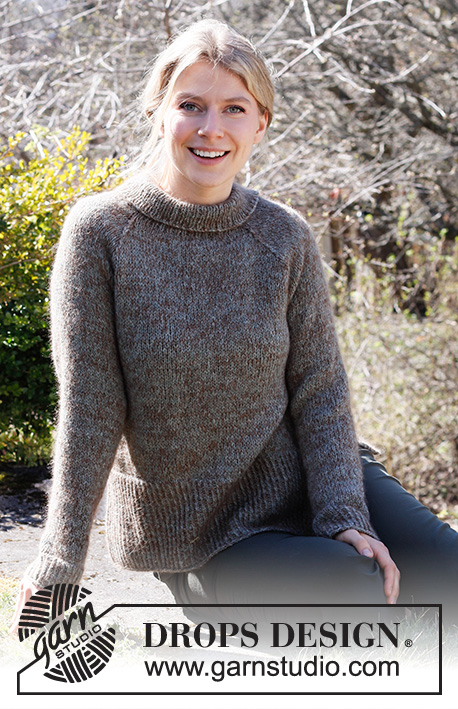
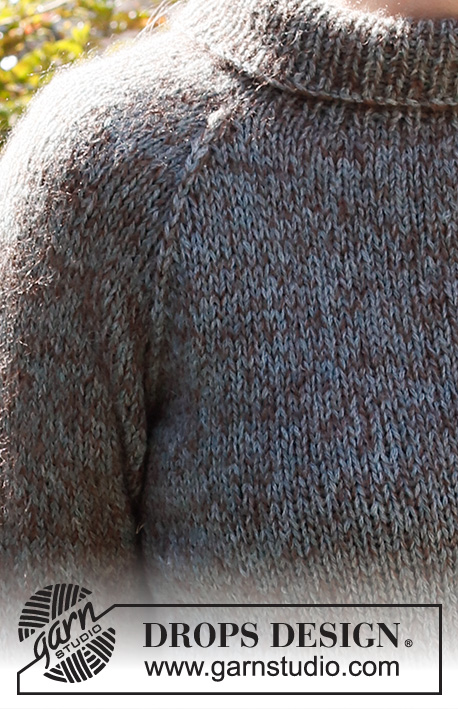

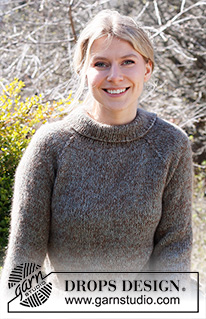

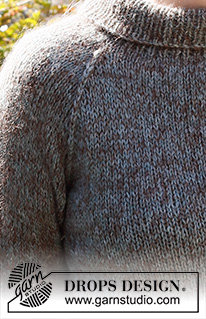







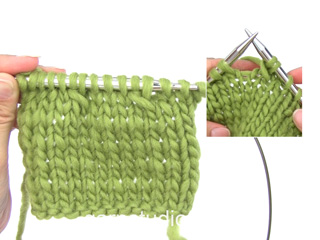





















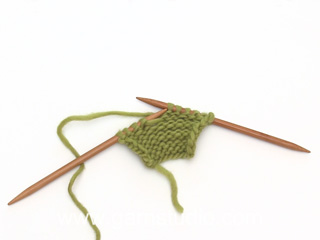






















Comments / Questions (11)
Hei, stemmer det at str XXl bare skal strikkes til 34 cm på armene? Det står: "Når ermet måler 39-38-37-35-34-32 cm" Jeg kan ikke forstå at et erme i stor størrelse skal være kortere enn i str S. Blir de ikke alt for korte? Håper på svar raskt - jeg har sendt tilsvarende spørsmål til Garnius men de svarer ikke (eller det tar 16 dager +). Med hilsen Camilla Nygren
13.03.2024 - 14:40DROPS Design answered:
Hei Camilla, Det er kortere ermer i større størrelsene pga videre skuldervidde og lengre bærestykke. Du kan allikevel justere ermelengden hvis du vil, ved å strikke lengre før man feller av til ermetoppen. God fornøyelse!
14.03.2024 - 12:36Hvorfor står det ikke mål i oppskriften, som overvidde, lengde m.m...?
15.07.2023 - 22:14DROPS Design answered:
Hei Anne, Du finner en målskisse på bunnen av oppskriften, med alle mål til alle størrelser. God fornøyelse!
17.07.2023 - 07:41Als je mindert voor de raglan zoals in dit patroon beschreven, waar blijft dan de markeerdraad? De markeerdraad zit in de 2e steek die wordt afgehaald en over de volgende wordt gehaald, dus dan verdwijnt hij toch als het ware in de overhaling?
01.12.2022 - 16:04DROPS Design answered:
Dag Jetje,
De steek die je op de rechter naald hebt na het minderen (dus de steek waar je de 2 afgehaalde steken overheen haalt), die kun je gebruiken om de markeerdraad weer in te zetten.
04.12.2022 - 16:28I have Sky wool in pale blue,which colour would you suggest for the alpaca silk?
16.09.2022 - 07:39DROPS Design answered:
Dear Mrs Mikha, for any assistance choosing the best matching colour, please contact your DROPS Store, it will be much easier for them to help you - even per mail or telephone Happy knitting!
16.09.2022 - 09:55Lower section of this jumper seems complicated. Where can I find a pattern for a bottom-up jumper with raglan sleeves?
16.03.2022 - 13:13DROPS Design answered:
Dear Charlene, you will find some of our jumpers worked bottom up with raglan sleeves here. Happy knitting!
16.03.2022 - 13:38Why are the stitches in the rib knitted from the back? Could I just knit them normally or would this affect the result greatly? Also: I have quite big holes whenever I increase using the "yarn over" method. Is there a better way for increasing? (Maybe I knit too loosely.)
08.02.2022 - 23:21DROPS Design answered:
Hi Imogen, The ribbing kan be worked as normal if you wish. It won't make much difference to the overall look of the jumper. When working the yarn overs after an increase, work them twisted (work in the back loop) to avoid holes. Happy knitting!
09.02.2022 - 07:48Hei! Dette står om økning i antall masker i ermene: "Når arbeidet måler 8-8-7-8-8-8 cm fra oppleggskanten, økes det 1 maske på hver side av merketråden." Jeg lurer på hva oppleggskant er. Er det selve starten på ermet eller er det linjen når vrangbord går over til glattstrikk?
09.04.2021 - 10:34DROPS Design answered:
Hei Gordana, Det er begynnelsen på ermet. God fornøyelse!
12.04.2021 - 07:01I do not know how to explain it i need a tutorial on how to cast off stiches for an armhole, when i finish the round there is one extra and it is in the middle of the gap, sjall i send a photo ?
10.03.2021 - 22:19DROPS Design answered:
Hi Beata, please send a photo to poland@dropsproject.com. Kind regards
11.03.2021 - 07:27I do not know how to cast off stiche for armholes, that is my right question, because when I have made a round and come to the place when I started casting off ( the first 4 stiches) and when I ended with casting four ( the other side of the back) it seems there is one stich right in the middle.
10.03.2021 - 16:44DROPS Design answered:
Witaj Beato, nie wiem czy dobrze zrozumiałam - czy po zamknięciu oczek na podkroje rękawów zostaje ci nadplanowe oczko?
10.03.2021 - 20:37Salve, c'è una tabella per le misure? La misura M e la misura L a quanti cm di cirf. seno corrispondono? Grazie anticipatamente
07.12.2020 - 19:13DROPS Design answered:
Buonasera Anita, in fondo alle spiegazioni può trovare il diagramma con le misure: le confronti con un capo di simile vestibilità per trovare la sua taglia. Buon lavoro!
07.12.2020 - 21:13